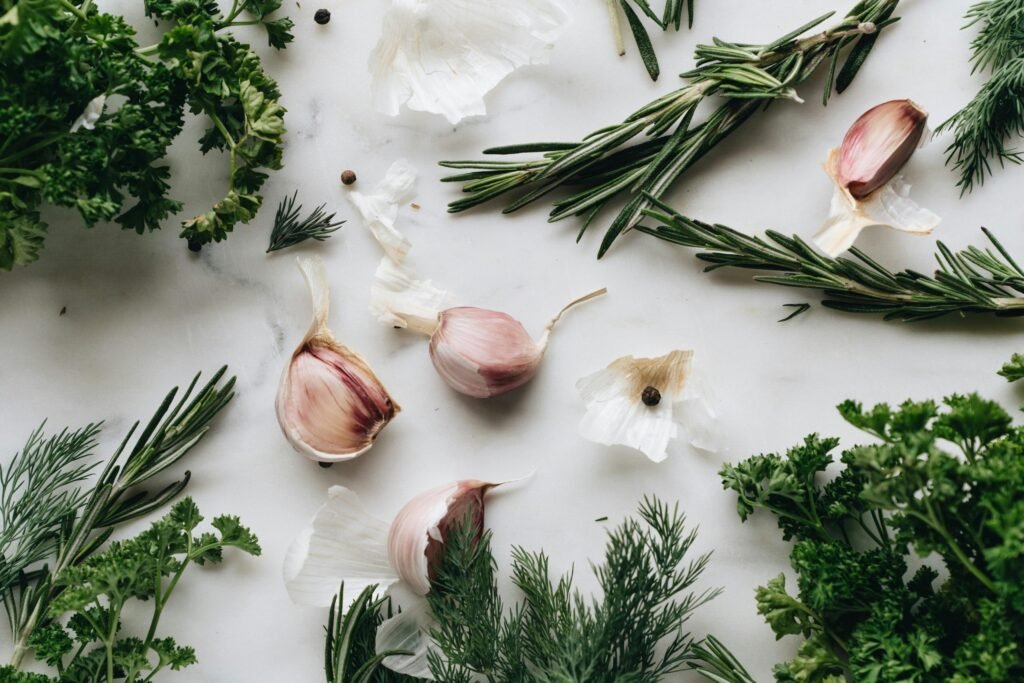If you’re seeking natural pain relief for joint discomfort, look no further than non-inflammatory foods and holistic approaches. These remedies are easy to incorporate into daily routines and support long-term joint health. By focusing on natural methods, you can reduce inflammation, soothe pain, and improve overall well-being.
From anti-inflammatory herbs to grounding practices, these tips offer a well-rounded approach. Combining mindfulness, essential oils, and dietary changes not only promotes pain relief but also enhances overall body harmony. Ready to explore?
Anti-Inflammatory Herbs for Natural Pain Relief
Reducing inflammation naturally is easier with powerful herbs like turmeric, ginger, and boswellia. These plants have been used for centuries and are known for their healing properties.

Turmeric: The Golden Healer
First up, turmeric! This bright yellow spice contains curcumin, a natural anti-inflammatory compound. Curcumin blocks certain enzymes in the body that trigger pain and swelling. By adding turmeric to your diet or taking it in supplement form, you’re giving your body a boost of natural pain relief. Plus, it’s delicious in curry or as a tea!
Ginger: The Zingy Pain Fighter
Next, ginger is another fantastic herb for reducing inflammation and soothing joint pain. It contains gingerol, a powerful compound that works similarly to anti-inflammatory drugs but without the side effects. Ginger also improves circulation, which helps deliver more oxygen and nutrients to inflamed areas. Whether you add fresh ginger to meals or sip on ginger tea, you’ll feel the benefits quickly.
Boswellia: The Ancient Wonder Herb
Boswellia, often called frankincense, is another herb you shouldn’t overlook. It’s packed with anti-inflammatory properties that help reduce pain and stiffness, especially in joints. By inhibiting certain enzymes that cause inflammation, boswellia can provide long-lasting relief. Taking boswellia as a supplement or using it in oil form can significantly improve your mobility and comfort.
How to Use These Herbs
Incorporating these herbs into your routine is simple. You can take turmeric and boswellia as capsules or enjoy ginger in teas or smoothies. If you’re seeking non-inflammatory foods, adding these herbs to your meals is an easy way to manage pain. Plus, they can add extra flavor and health benefits to your diet.
These herbs are an excellent way to manage joint pain naturally. Whether through food, teas, or supplements, these anti-inflammatory powerhouses can give you the relief you need while supporting overall health!
Anti-Inflammatory Diet Basics: A Natural Guide to Pain Relief
Eating the right foods can help manage inflammation and reduce joint discomfort. When it comes to finding natural pain relief, an anti-inflammatory diet is key.

Focus on Omega-3s for Natural Pain Relief
First, omega-3 fatty acids are a major player in reducing inflammation. Foods like salmon, walnuts, and flaxseeds are packed with these healthy fats. By regularly incorporating them into your diet, you’ll help lower inflammation and improve joint health.
Include Plenty of Anti-Inflammatory Fruits and Vegetables
Additionally, fruits and veggies are essential. Berries, leafy greens, and tomatoes contain antioxidants that reduce inflammation. Transitioning to more colorful, plant-based meals can be one of the easiest ways to support natural pain relief.
Limit Processed Foods and Refined Sugars
On the flip side, processed foods and sugary treats can trigger inflammation. Instead, choose whole, non-inflammatory foods like whole grains and lean proteins. You’ll not only reduce pain but feel more energized too.
Stay Hydrated for Better Joint Function
Hydration is also crucial for joint health. Drinking plenty of water helps keep your joints lubricated and reduces stiffness. Even herbal teas and water-rich fruits can support your body’s ability to combat inflammation.
Incorporating anti-inflammatory foods into your daily meals can make a huge difference in how you feel. With some small adjustments, you’ll be well on your way to natural pain relief and healthier joints!
Heat and Cold Therapy: Natural Pain Relief for Joint Discomfort
Alternating between heat and cold therapy is a simple, natural way to ease joint pain. Whether you’re dealing with inflammation or stiffness, these treatments can help you feel better.

Heat Therapy for Natural Pain Relief
First, heat therapy works wonders on stiff joints. Applying a warm compress helps relax muscles, improve blood flow, and soothe tightness. A heating pad or a warm towel can work great.
Cold Therapy to Reduce Inflammation
On the other hand, cold therapy helps reduce inflammation and swelling. Using an ice pack or a cold compress numbs the pain and minimizes swelling. It’s best for acute pain or after activities that might irritate your joints.
Alternating Between Heat and Cold
Additionally, alternating between heat and cold can provide even more relief. Start with heat for about 15 minutes, then switch to cold for another 15 minutes. This combination reduces pain, inflammation, and stiffness all at once.
Consistency is Key for Effective Results
Finally, you’ll want to use heat and cold therapy regularly. While the relief may not be instant, consistency will make a difference. Make it a part of your natural pain relief routine, and you’ll notice improvements over time!
By alternating heat and cold compresses, you can easily incorporate this natural pain relief method into your daily routine. It’s a great way to keep inflammation and discomfort under control without any harsh treatments!
The Power of Essential Oils for Natural Pain Relief
Essential oils are a natural and soothing way to calm sore, inflamed joints. Oils like lavender, eucalyptus, and copaiba are well-known for their pain-relieving properties.

Lavender for Relaxation and Pain Relief
First, lavender is famous for its calming effects, but it also provides natural pain relief. Applying diluted lavender oil to sore joints can ease both tension and discomfort. Its anti-inflammatory properties make it a top choice for relieving joint pain naturally.
Eucalyptus: Cooling Comfort for Inflammation
On the other hand, eucalyptus oil offers a cooling sensation that reduces inflammation. It works wonders when you’re dealing with swelling, offering fast, soothing relief. Massage a few drops of eucalyptus oil into your skin to help ease stiffness and inflammation.
Copaiba: A Powerful Anti-Inflammatory
Copaiba oil is another lesser-known but effective option for joint pain. Known for its strong anti-inflammatory benefits, it helps reduce swelling and discomfort. When used regularly, copaiba oil can help calm inflamed joints and support natural pain relief over time.
How to Use Essential Oils for Joint Pain
Incorporating these oils into your routine is simple. Apply diluted essential oils directly to the sore areas, or add them to a warm bath for a relaxing soak. You can also use them in aromatherapy to enhance the calming effects on both body and mind.
Combining Oils for Maximum Relief
Finally, consider blending oils for an extra boost. For example, mixing lavender and eucalyptus can create a soothing and cooling effect that targets both tension and inflammation.
By exploring the power of essential oils, you can easily incorporate natural pain relief into your routine. Oils like lavender, eucalyptus, and copaiba offer calming, anti-inflammatory benefits that can make a big difference in your joint health.
Meditation and Grounding for Natural Pain Relief
Meditation and grounding aren’t just for relaxation—they offer natural pain relief, too. These mindfulness techniques help you shift focus away from discomfort and calm inflammation.

Mindfulness Meditation for Pain Perception
First, mindfulness meditation trains your mind to observe pain without letting it overwhelm you. By focusing on your breath and staying present, you can reduce the emotional impact of pain and support natural pain relief.
Grounding: Connecting with Nature
Additionally, grounding (or “earthing”) involves physically connecting with the earth, like walking barefoot on grass. This simple practice reduces inflammation and helps balance your body’s natural healing processes. Please, read more on grounding methods, options and benefits here.
The Science Behind Meditation and Grounding
Interestingly, research shows that both meditation and grounding lower cortisol levels, the hormone associated with stress and inflammation. Lowering cortisol naturally reduces joint inflammation, aiding overall pain relief.
How to Incorporate Meditation Into Your Routine
To get started, try meditating for just five minutes a day. You can sit quietly, breathe deeply, and focus on how your body feels. Over time, this practice can significantly improve how you perceive pain.
Combining Meditation with Anti-Inflammatory Foods
Finally, combining meditation with non-inflammatory foods, such as leafy greens and fatty fish, creates a well-rounded approach to natural pain relief. Both work together to reduce inflammation and improve joint health.
By using meditation and grounding techniques, you can ease the perception of pain and support your body’s natural healing, helping you live a healthier, pain-free life.
Conclusion
When it comes to natural pain relief, it’s about finding balance. Grounding, mindfulness, and essential oils calm the mind and reduce inflammation. Paired with non-inflammatory foods, these simple practices target pain at its root and offer long-lasting benefits.
Start by making small changes. Add anti-inflammatory foods to your diet and take five minutes a day to meditate. Over time, you’ll notice a remarkable difference in both your joint health and overall well-being.

